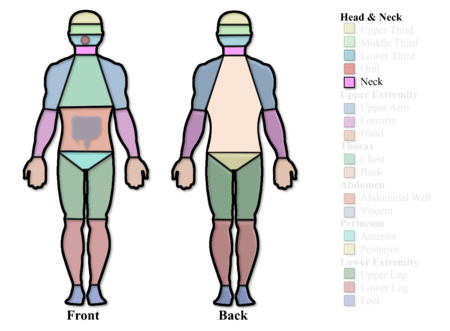Head & Neck Flaps: Neck
Appearance
This page contains a detailed table of local flaps that can be used to reconstruct defects of the Neck as well as free flaps from this donor site that may be used for reconstruction elsewhere in the body.
Table of Regional Flaps[edit | edit source]
| Region | Sub-Region | Flap Name | Abbreviation(s) & Eponynms | Variations | Blood Supply | Source Vessels | Perforator Type | Mathes & Nahai (muscle) | Mathes & Nahai (fascial) | Pedicled | Free | Skin | Mucosa | Fascia | Muscle | Nerve | Bone | Cartilage | Viscera | Lymph Node |
|---|---|---|---|---|---|---|---|---|---|---|---|---|---|---|---|---|---|---|---|---|
| H&N | Neck | Platysma | - | - | Axial | Submental artery | Musculocutaneous | II | - | + | - | + | - | - | + | - | - | - | - | - |
| H&N | Neck | Sternocleidomastoid | SCM | osseomusculocutaneous with the entire or partial medial third of the clavicle | Axial | Sternocleidomastoid artery and transverse cervical artery branch for the lower third of the flap | Musculocutaneous | II | - | + | - | + | - | - | + | - | - | - | - | - |
Table Labels & Definitions[edit | edit source]
- Region & Sub-Region: General region and more specific sub-regions of the body where the flap is located.
- Head & Neck
- Upper Third
- Middle Third
- Lower Third
- Oral
- Neck
- Upper Extremity
- Upper Arm
- Forearm
- Hand
- Thorax
- Chest
- Back
- Abdomen
- Abdominal Wall
- Viscera
- Perineum
- Anterior
- Posterior
- Lower Extremity
- Upper Leg
- Lower Leg
- Foot
- Any (i.e. not region specific)
- Head & Neck
- Sub-Region: More specific sub-region of the body where the flap is located.
- Flap Name: Most common name used to refer to a given flap. Alternative names including abbreviated versions and Eponyms are listed in the following column.
- Abbreviation(s) & Eponyms: Identifies any abbreviations (i.e. often related to anatomy) or Eponymous names for the flap.
- Variations: Potential modifications or alterations in the flap that are utilized depending on the reconstructive need. See examples below.
- Bilateral harvesting
- Innervation allowing sensate and neurotized (muscle) flaps
- Chimeric (mixed circulatory anatomy allowing independent segments of the flap
- Blood Supply: This column identifies which flaps have either Random or Axial blood supplies.
- Random: This type of flap is purely supplied by the subdermal plexus and other dermal plexi of the skin without a defined "axial" or "source" vessel that can be dissected out or isolated.
- Axial: This type of flap receives perfusion from a defined "source" vessel that is anatomically preserved and may be dissected out either for pedicled or free flap
- Source Vessels: This column identifies the specific blood vessels that provide circulation to the flap.
- Perforator Type: Each flap is assigned a specific perforator type (see below for details) which is an anatomically based description of the pathway that the source vessel travels in relation to surrounding anatomy and is important in guiding flap dissection. Both muscle/musculocutaneous and fascial/fasciocutaneous flaps have perforator types and are not mutually exclusive.
- Direct Cutaneous
- Septocutaneous
- Musculocutaneous
- Muscle
- Variable
- "-" =indicates no applicable perforator type
- Mathes & Nahai (muscle): A specific Roman Numeral (i.e. I through V) indicates that this flap may be classified using the Mathes & Nahai Fascia & Fasciocutaneous Flap Classification. See below for descriptions of the classification letters.
- I: one Major blood supply
- II: one Major & one Minor blood supply
- III: two Major blood supplies
- IV: Segmental blood supply
- V: One Major & Segmental blood supplies
- "-" =indicates no Mathes & Nahai Muscle Flap Classification is applicable
- Mathes & Nahai (fascia): A specific letter (i.e. A, B, C) indicates that this flap may be classified using the Mathes & Nahai Fascia & Fasciocutaneous Flap Classification. See below for descriptions of the classification letters.
- A: Cutaneous (direct) perforator that travels directly to the skin from the source vessel and not perforate through muscle or septi.
- B: Septocutaneous perforator that travels in between muscles via the intermuscular septi prior to reaching the skin.
- C: Musculocutaneous perforator that goes through muscle prior to reaching the skin.
- B/C: Variable anatomy with either septo- or musculocutaneous perforator anatomy.
- "-" =indicates no Mathes & Nahai Fascial Flap Classification is applicable
- Pedicled Flap: "+" indicates this flap may be used as a pedicled flap meaning that the blood supply remains connected at the original anatomic site.
- Free Flap: "+" indicates this flap may be used as a free flap meaning that the blood supply is transected at the original anatomic site and then the flap is transferred to another regional or distant site where arterial and venous anastomosis must be performed to re-establish perfusion.
- Tissue Composition: This series of columns is used to identify which tissue types may be contained within the designated flap. "+" indicates the flap may include this tissue type. "-" indicates the flap does not have the potential to include that tissue type. See potential tissue types below.
- Skin
- Mucosa
- Fascia
- Muscle
- Nerve
- Bone
- Cartilage
- Viscera
- Lymph Nodes
Self assessment[edit | edit source]
Self-assessment
- Review the contents of this page as well as the rest of the pages related to the Flaps & Classification section then go to the AmoSmile App to take the Self-Assessment quiz on Flaps & Classifications.
- See Z-Plasty Module navigation page for app download instructions.
